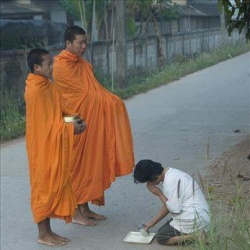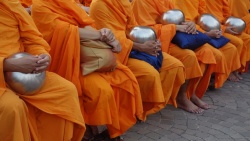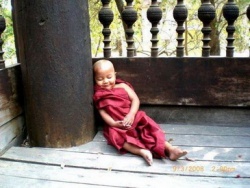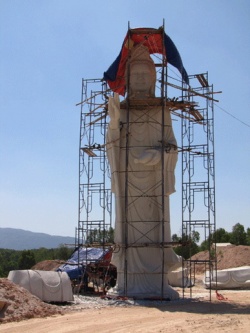The Practice of Sangha
The Arya Sangha is the noble or holy Sangha, the spiritual community of all those who have experienced some insight into the nature of reality. This is the Sangha of those who have reached a stage in their spiritual life which means that they can never fall back from the Path. They have seen into the nature of reality and what has become clear to them can never become unclear again. This is the point of Stream Entry. A Stream Entrant is a spiritual practitioner who has seen through fixed self-view, has seen through doubt and indecision and has seen through any tendency to go through the motions of spiritual practice.
Bhante talks about a Stream Entrant in positive terms as someone who has transcended habit, vagueness and superficiality and attained creativity, clarity and commitment. Stream Entry occurs when we break through these three fetters of self-view, doubt, and going through the motions of practice. The first fetter is the habit of being a particular kind of person. We act as if we have always been and will always be a particular kind of person with particular abilities and shortcomings. Consciously or unconsciously we tell ourselves stories about who we are and what we can and cannot do and we keep on telling ourselves the same stories, constantly reinforcing a particular version of 'me' with a capital M. A Stream Entrant is someone who breaks through this and has a much more creative experience of themselves and others. A Stream Entrant is always aware of the greater potential that has yet to unfold, and the Buddha nature yet to be unveiled. The second fetter is doubt and indecision or a constant lack of clarity.
This is an emotionally based avoidance of clarity and truth. This is throwing up obstacles constantly to deliberately obscure the truth about ourselves and about life. This kind of doubt and indecision is a resistance to going deeper into things, a resistance to clarifying what the Dharma is all about, a resistance to the implications of practice. It is closely related to the first fetter because this resistance is all about preserving a fixed self-view.
A Stream Entrant is completely free of doubt about the Buddha, Dharma and Sangha and it is therefore no great effort for a Stream Entrant to place trust in the Three Jewels. The third fetter is the tendency to go through the motions of practice or as it is usually put, reliance on rites and rituals as ends in themselves. When we have been practising for a while we can lose sight of the purpose of practice and then our practice of meditation, puja, study and even ethics becomes empty of deeper meaning. We may forget about the spiritual goal of becoming more aware and more compassionate - we may forget that we're trying to undermine selfishness and harshness and gain more wisdom and equanimity.
We may meditate in order to have good meditations or to have strong experiences. We may do puja in order to feel good and get a bit of a buzz. We may study simply to acquire knowledge and we may practice ethics to be a good Buddhist, but we have forgotten the higher ideal, we have forgotten about Insight and Enlightenment and we are satisfied with being a little bit happier. This is the fetter of superficiality as Bhante calls it. It keeps us on the surface of our own experience and keeps us immunised against the reality of dissatisfaction, impermanence and insubstantiality. It means we have lost creativity in our practice, we no longer have a cutting edge in our spiritual life - we're a bit lost and in need of reorientation and re-inspiring. A Stream Entrant is constantly aware of the reason for practice, constantly on a path of compassion and awareness.
A Stream Entrant has broken through these fetters of fixed self-view, doubt and indecision and superficiality and has insight into the real reason for spiritual practice. Stream Entrants and all those even more advanced make up the Arya Sangha, the noble Sangha. This is the Sangha we Go for Refuge to, this is the Sangha we can rely on. This Sangha, the Arya Sangha, is the living breathing Dharma. This is where the teachings of the Buddha leave off being concepts or images and take on human form.
The teachings live in the Arya Sangha and it is because the teachings have stayed alive in this way that it is still possible for us to encounter the essential spirit of Buddhism. Currently I am reading ‘Buddha in the Jungle’ by Kamala Tiyavanich, (follow up to Forest Recollections) which recounts the stories of many remarkable Buddhists in Thailand in the 19th and 20th centuries. These great Dharma farers were characterised by unremitting faith in the Three Jewels and unstained morality. Their practise of the first precept was particularly outstanding.
It would appear that many of them were probably more than Stream Entrants. According to the Sangiti Sutta in the Digha Nikaya you can recognise a Stream Entrant by four characteristics: 1. Unwavering confidence in the Buddha. 2. Unwavering confidence in the Dharma. 3. Unwavering confidence in the Sangha and 4. Being possessed of morality or as the text says "he is possessed of morality dear to the noble ones, unbroken, without defect, unspotted, without inconsistency, liberating, praised by the wise, uncorrupted, and conducive to concentration". Elsewhere it says that a Stream Entrant will confess any breaches of Precepts immediately. (Kosambiya Sutta, Majjhima Nikaya 48(11)). However it is not easy to tell whether another person is spiritually developed or not; externals such as behaviour and speech can tell you something but not everything. There is a Sutta in the Numerical Discourses entitled ‘How to judge a person's character’ and here's what it says: “ Four facts about a person, O monks, can be known from four circumstances. What are these four? By living together with a person his virtue can be known, and this too only after a long time, not casually; by close attention, not without attention; by one who is wise, not by one is stupid. By having dealings with a person his integrity can be known, and this too only after a long time, not casually; by close attention, not without attention; by one who is wise, not by one who is stupid. In misfortune a person's fortitude can be known, and this too only after a long time, not casually; by close attention, not without attention; by one who is wise, not by one who is stupid. By conversation a person's wisdom can be known, and this too only after a long time, not casually; by close attention, not without attention; by one who is wise, not by one who is stupid." (Numerical Discourses of the Buddha, Nyanaponika & Bodhi, No. 88) If you really want to tell whether someone is a stream entrant, you have to develop attentiveness and wisdom and then you need to live with them, work with them (have dealings with), be around them at times when things are going badly and be in communication with them. It is not an easy matter to judge another person's character or the nature of their spiritual development. You need to have substantial experience of them, but perhaps more importantly you need to know yourself, so that your view of someone else isn't just a projection of the unconscious contents of your own mind. This is what I think is meant by a wise person or an attentive person. The Arya Sangha is a very important level of Sangha. This is where the Dharma is embodied, where the Dharma is kept alive in its essential spirit. This is the Sangha that we need to create among ourselves. If we are intent on finding Stream Entrants or realised gurus or great spiritual beings we are probably engaged in the business of looking for a saviour. But Buddhism is the wrong place to look for saviours. The Buddha never claimed to be a saviour; he only claimed to be one who points out the path. The Arya Sangha can do no more. If we put people up on pedestals and worship them and try to turn them into saviours, we will only be disappointed. Nobody can save us. Nobody can live our life for us. Our spiritual friends are part of the conditions which help us to make an effort with spiritual practice but the effort is all our own. We can draw inspiration from the lives of others, past and present, but we have to act from that inspiration. We need to become Stream Entrants. In that way we become a refuge unto ourselves. Sangha, or spiritual community is not an organisation, not even an ecclesiastical organisation. It is a common response to the Ideal, a shared response and a shared practice. It is being on same wavelength. It is something dynamic, something that happens, something that people do. It is not a fixed thing. We can have labels, such as Bhikku or Lama or Dharmachari/ini or Mitra or Order Member, but these are just labels. Spiritual community transcends labels; spiritual community is the actual experience of a ‘coincidence of wills’, an experience of resonance with the spiritual aspirations and spiritual endeavours of others. I think it is best to think of spiritual community or Sangha as a practice rather than as an institution that you become a member of. Membership is a completely unhelpful metaphor. Sangha is something you do rather than an organisation you belong to. It is something you practise both in public and in private. You come across this phrase in the Pali canon in relation to harmony between monks; harmony is maintained and lost because of what they do and say and think ‘both in public and in private’. Here's what the Sangiti Sutta says about the practice of spiritual community: “ Six things are conducive to communal living. As long as monks both in public and in private show loving kindness to their fellows in acts of body speech and thought,…. share with their virtuous fellows what ever they receive as a rightful gift, including the contents of their alms bowls, which they do not keep to themselves,… keep consistently, unbroken and unaltered those rules of conduct that are spotless, leading to liberation, praised by the wise, unstained and conducive to concentrationd persist therein with their fellows both in public and in private,… continue in that noble view that leads to liberation, to the utter destruction of suffering, remaining in such awareness with their fellows both in public and in private.” There is this interesting repetition of the phrase "in public and in private" which reinforces the idea that spiritual community is a practice. In this case it is a practice of loving kindness, generosity, ethics and right view. The text goes on to say how problems arise in the spiritual community and by implication tells us what we need to avoid: “ Six roots of contention: here, (a) a monk is angry and bears ill will, he is disrespectful and discourteous to the Teacher, the Dhamma and the Sangha, and does not finish his training. He stirs up contention within the Sangha, which brings woe and sorrow to many, with evil consequences, misfortune and sorrow for devas and humans. If, friends, you should discover such a root of contention among yourselves or among others, you should strive to get rid of just that root of contention. If you find no such root of contention, then you should work to prevent its overcoming you in future. Or (b) a monk is deceitful and malicious,…(c) a monk is envious and mean,…(d) a monk is cunning and deceitful,….(e) a monk is full of evil desires and wrong views,…(f) a monk is opinionated, obstinate and tenacious. If, friends, you should discover such a root of contention among yourselves or among others, you should strive to get rid of just that root of contention. If you find no such root of contention then you should work to prevent its overcoming you in future.” This points to the sort of practice we need to undertake if we want to create a spirit of Sangha among ourselves. To put it more positively we need to cultivate goodwill and be respectful to the Three Jewels and to our teachers. We need to be honest and kindly and we need to forgive others and give freely. We need to be open in our dealings with each other. We need to study and discuss so that we develop right views about the nature of existence. We need to hold our opinions lightly and be less attached to them. We can be too literal-minded about spiritual community or Sangha. We can start to expect the ideal of spiritual community to manifest around us all the time, because of what we have read or heard. But in order to stay on the path of Dharma, to keep our feet on the ground, we have to be able to hold in our minds and hearts the twin realities of a spiritual community that is imperfect, inadequate, stumbling and struggling and a spiritual community which is the embodiment of the Bodhisattva Ideal - a manifestation of the compassion of Avolokitesvara. These two realities are the same Reality - one is trapped in time and the literal mindedness of self-centredness and the other is free of the limitations of time and always creating itself anew in the free space of imagination. Because we can imagine, we can respond to ideals - ideals motivate us to great endeavour as we try to realise in time and space what we have intuited. Ideals activate our deep imagination, they move us and rouse our energies and from that grows the urge, even the need, to follow the spiritual path and undergo the trials and struggles that are an inevitable part of the journey from the unawakened state to the Awakened state, from unawareness to full awareness. Sometimes it seems that the biggest trial we meet on the spiritual path is the people around us - it can seem that we would be much better off going it alone - perhaps with access to a kindly teacher whenever we needed advice. We can feel that we would be better off without all the emotional messiness of our interaction with others on the path. But without communication with others on the path there would be no path. The path is not distinct from the practitioners and it is the communication between practitioners that keeps the Dharma alive and fully embodied, both as the way of compassion and the way of Wisdom. To progress spiritually we have to move beyond all self-centredness and it is in the practice of creating and maintaining spiritual community that ego transcendence is most potently and directly approached. We can be hindered by having expectations that ourselves and others maintain high standards of perfect ethics, meditation and wisdom all the time. But if we are to progress we must first accept what is already there in our experience and become thoroughly familiar with the landscape of our own mind - valuing all that is worthwhile and precious there. This is quite a crucial point - we must learn to recognise what is already of spiritual, psychological and utilitarian value in our lives and in the lives of others. From this basis of recognising and appreciating what is of value in ourselves, in others and in situations we can proceed to change or improve things, but we need this foundation of appreciation or our efforts to improve will be perverted. There is a temptation to rush in with 'off the peg' ideas to improve ourselves or others or situations without taking the time to appreciate fully what is already there. We can expect ourselves and others to be imperfect. We can expect the spiritual community to be imperfect, we can expect Order members to be imperfect, we can expect the situations and institutions we create to be imperfect, but this need not blind us to what is of value there, what potential beauty and transcendence is there. Ideals are essential. Imagination, the higher faculty of human consciousness, demands and creates ideals. Our intuition and imagination responds to ideals and we need to use our reason and experience to keep a perspective that includes the highest ideals and also recognises and appreciates the actual situation and its potential. We can pursue perfection but not expect perfection. We can expect imperfection but not pursue imperfection. This attitude will help us maintain a realistic perspective on our spiritual efforts and on our relationships with others. We can be realistic about the spiritual community while at the same time understanding and responding to the ideal of the spiritual community - the ideal of compassion in action.





